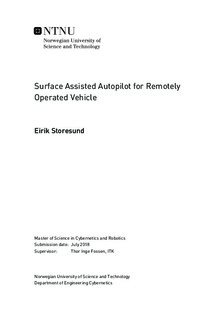Surface Assisted Autopilot for Remotely Operated Vehicle
Master thesis
Permanent lenke
http://hdl.handle.net/11250/2560559Utgivelsesdato
2018Metadata
Vis full innførselSamlinger
Sammendrag
The following thesis was done in collaboration with Water Linked AS and theNorwegian University of Science and Technology. The task at hand was to demon-strate wireless control of an ROV done with Water Linked s Underwater Modem.The demonstration took place during the final phase of the SWARMs (Smart andNetworking Underwater Robots in Cooperation Meshes) research project 26. June2018.
The Underwater Modem makes wireless underwater communication possible. TheDownlink provides communication from a topside computer to a subsea ROV, whilethe Uplink provides a video stream subsea to topside. This thesis focus solely onthe Downlink to demonstrate a safe and robust system for controlling a BlueRov2from BlueRobotics wirelessly.
The BlueRov2 is an affordable, high performance ROV, which is highly customizable.The ROV is normally connected with a tether going to a topside computer, but butusing the Underwater Modem system, the tether is omitted. The Downlink requiresan additional waterproof payload on the ROV, a Subsea Master unit, which wasmounted on the ROV.
To control the ROV, software on both the Raspberry Pi on board the ROV (OBC)and topside computer was be made. Two different devices was integrated to providepilot input for the ROV, an Xbox controller and the Intuitive Input Device (IID)from Inventas AS. To be able to control the ROV with a limited amount ofbandwidth, 4 bytes per second, the transmitted data is parsed and encoded. Thecontrol commands provides control of four degrees of freedom, as well as giving theopportunity to turn off and on light, change the control mode and adjust pilot gain.On the OBC, the control commands are received and decoded. To control the ROV,a variety of software is used. ArduSub runs on the Pixhawk Flight Controller Unit(FCU), and the ROS framework is used to interface with the FCU, through theMAVROS package. How the software on both the topside computer and the OBCis implemented is explained in detail in the thesis.
Before demonstration the system in SWARMs project, vigorous testing was performed. To find tool and methods for testing, Software Development Life Cycle methods was explored. This provided testing tools that ensured that the demonstration was a success.
